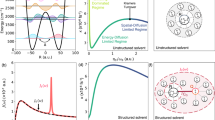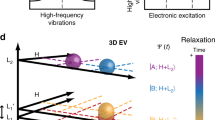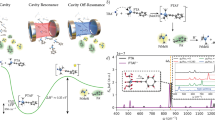Abstract
Mode selectivity is a well-established concept in chemical dynamics. A polyatomic molecule possesses multiple vibrational modes and the mechanical couplings between them can result in complicated anharmonic motions that defy a simple oscillatory description. A prototypical example of this is Fermi-coupled vibration, in which an energy-split eigenstate executes coherent nuclear motion that is comprised of the constituent normal modes with distinctive phases. Will this vibrational phase affect chemical reactivity? How can this phase effect be disentangled from more classical amplitude effects? Here, to address these questions, we study the reaction of Cl with a pair of Fermi states of CH3D(v1-I and v1-II). We find that the reactivity ratio of (v1-I)/(v1-II) in forming the CH2D(v = 0) + HCl(v) products deviates significantly from that permitted by the conventional reactivity-borrowing framework. Based on a proposed metric, this discrepancy can only be explained when the scattering interferences mediated by the CH3D vibrational phases are explicitly considered, which expands the concept of vibrational control of chemical reactivity into the quantum regime.

This is a preview of subscription content, access via your institution
Access options
Access Nature and 54 other Nature Portfolio journals
Get Nature+, our best-value online-access subscription
$29.99 / 30 days
cancel any time
Subscribe to this journal
Receive 12 print issues and online access
$259.00 per year
only $21.58 per issue
Buy this article
- Purchase on Springer Link
- Instant access to full article PDF
Prices may be subject to local taxes which are calculated during checkout



Similar content being viewed by others
Data availability
Datasets are available at https://doi.org/10.5281/zenodo.6119459 (ref. 38) and as Supplementary Data 1.
References
Levine, R. D. Molecular Reaction Dynamics (Cambridge Univ. Press, 2005).
Crim, F. F. Vibrational state control of bimolecular reactions: discovering and directing the chemistry. Acc. Chem. Res. 32, 877–884 (1999).
Crim, F. F. Bond-selected chemistry: vibrational state control of photodissociation and bimolecular reaction. J. Phys. Chem. 100, 12725–12734 (1996).
Zare, R. N. Laser control of chemical reactions. Science 279, 1875–1879 (1998).
Liu, K. Vibrational control of bimolecular reactions with methane by mode, bond, and stereo selectivity. Annu. Rev. Phys. Chem. 67, 91–111 (2016).
Pan, H., Liu, K., Caracciolo, A. & Casavecchia, P. Crossed beam polyatomic reaction dynamics: recent advances and new insights. Chem. Soc. Rev. 46, 7517–7547 (2017).
Crim, F. F. Chemical dynamics of vibrationally excited molecules: controlling reactions in gases and on surfaces. Proc. Natl Acad. Sci. USA 105, 12654–12661 (2008).
Guo, H. & Jiang, B. The sudden vector projection model for reactivity: mode specificity and bond selectivity made simple. Acc. Chem. Res. 47, 3679–3685 (2014).
Herzberg, G. Molecular Spectra and Molecular Structure, Vol. II: Infrared and Raman Spectra of Plyatomic Molecules (Van Nostrand-Reinhold,1945).
Dixon, R. N. Anomalous band intensity in Fermi resonance. J. Chem. Phys. 31, 258–260 (1959).
Ellerbrock, R. & Manthe, U. Communication: Reactivity borrowing in the mode selective chemistry of H + CHD3 → H2 + CD3. J. Chem. Phys. 147, 241104 (2017).
Zhao, B., Manthe, U. & Guo, H. Fermi resonance controlled product branching in the H + HOD reaction. Phys. Chem. Chem. Phys. 20, 17029–17037 (2018).
Wang, X. G. & Sibert, E. L. III A nine-dimensional perturbative treatment of the vibrations of methane and its isotopomers. J. Chem. Phys. 111, 4510–4522 (1999).
Yoon, S., Holiday, R. J., Sibert, E. L. III & Crim, F. F. The relative reactivity of CH3D molecules with excited symmetric and antisymmetric stretching vibrations. J. Chem. Phys. 119, 9568–9575 (2003).
Liu, K. Vibrational-induced steric effects in bimolecular reactions. J. Chem. Phys. 142, 080901 (2015).
Pan, H., Wang, F. & Liu, K. Multifaceted stereoselectivity in polyatomic reactions. J. Phys. Chem. A 124, 6573–6584 (2020).
Wang, F., Lin, J. S. & Liu, K. Steric control of the reaction of CH stretch-excited CHD3 with chlorine atom. Science 331, 900–903 (2011).
Wang, F., Liu, K. & Rakitzis, T. P. Revealing the stereospecific chemistry of the reaction of Cl with aligned CHD3(v1 = 1). Nat. Chem. 4, 636–641 (2012).
Pan, H. & Liu, K. Active stereo-control of the Cl + CH4(ν3 = 1) reaction: a three-dimensional perspective. Phys. Chem. Chem. Phys. 22, 10949–10956 (2020).
Lin, J. J., Zhou, J., Shiu, W. & Liu, K. Application of time-sliced ion velocity imaging to crossed molecular beam experiments. Rev. Sci. Instrum. 74, 2495–2500 (2003).
Pan, H., Mondal, S., Yang, C.-H. & Liu, K. Imaging characterization of the rapid adiabatic passage in a source-rotatable, crossed-beam scattering experiment. J. Chem. Phys. 147, 013928 (2017).
Pan, H. & Liu, K. Pair-correlated imaging of Cl + CH3D(v4, v1-I, v1-II = 1, |jK〉) → CH2D(vi) + HCl(v). J. Phys. Chem. A 125, 6731–6738 (2021).
Pan, H. & Liu, K. Imaging spectroscopy of the missing REMPI bands of methyl radicals: final touches on all vibrational frequencies of the 3p Rydberg states. J. Chem. Phys. 148, 014303 (2018).
Zhou, J., Lin, J. J. & Liu, K. Mode-correlated product pairs in the F + CHD3 → DF + CHD2 reaction. J. Chem. Phys. 119, 8289–8296 (2003).
Liu, K. Product pair correlation in bimolecular reactions. Phys. Chem. Chem. Phys. 9, 17–30 (2007).
Yan, S., Wu, Y. T., Zhang, B. L., Yue, X. F. & Liu, K. Do vibrational excitations of CHD3 preferentially promote reactivity toward the chlorine atom? Science 316, 1723–1726 (2007).
Nyman, G., Zhou, J., Zhang, B. & Liu, K. Crossed-beam and quantum dynamics studies of the reaction Cl + CHD3. Isr. J. Chem. 47, 1–9 (2007).
Mondal, S. & Liu, K. Effects of stretching excitations in Cl + CH3D(v4, v1-I, v1-II = 1): as the Cl atom attacks the unexcited C–D bond. J. Phys. Chem. A 123, 1514–1520 (2019).
Ohmori, K. Wave-packet and coherent control dynamics. Annu. Rev. Phys. Chem. 60, 487–511 (2009).
Wollenhaupt, M. & Baumert, T. Ultrafast laser control of electron dynamics in atoms, molecules and solids. Faraday Discuss. 153, 9–26 (2011).
Liu, K. Quantum dynamical resonances in chemical reactions: from A + BC to polyatomic systems. Adv. Chem. Phys. 149, 1–46 (2012).
Polanyi, J. C. Some concepts in reaction dynamics. Science 236, 680–690 (1987).
Sonnenfroh, D. M. & Liu, K. Number density-to-flux transformation revisited: kinematic effects in the use of laser-induced fluorescence for scattering experiments. Chem. Phys. Lett. 176, 183–190 (1991).
Rothman, L. S. et al. The HITRAN2012 molecular spectroscopic database. J. Quant. Spectrosc. Radiat. Transfer 130, 4–50 (2013).
Cheng, Y., Pan, H., Wang, F. & Liu, K. On the signal depletion induced by stretching excitation of methane in the reaction with the F atom. Phys. Chem. Chem. Phys. 16, 444–452 (2014).
Feynman, R. P., Leighton, R. B., Sands, M. L. Feynman Lectures on Physics Vol. 3 (Addison Wesley, 1963).
Zhou, H., Perreault, W. E., Mukherjee, N. & Zare, R. N. Quantum mechanical double slit for molecular scattering. Science 374, 960–964 (2021).
Acknowledgements
We thank S. I. Mondal for assisting with some imaging acquisitions; S. Liu for providing the PES shown in Fig. 3a; H. Guo, D. H. Zhang, S. Liu and J. L. Kuo for helpful discussions. K.L. is indebted to A. Stolow for a stimulating discussion on the H + CO2 reaction at a 2014 meeting in St Petersburg, which eventually led to this project. This work was supported by Minister of Science and Technology of Taiwan (MOST-105-2113-M-001-019) and Academia Sinica (2318-1030200). H.P. also acknowledges support from the National Natural Science Foundation of China (grant 22003024), the Guangdong Introduced Innovative R&D Team Project (grant 2019ZT08L455) and the State Key Laboratory of Molecular Reaction Dynamics (grant SKLMRD-K202119). The funders had no role in study design, data collection and analysis, decision to publish or preparation of the manuscript.
Author information
Authors and Affiliations
Contributions
K.L. conceived and supervised the project. H.P. performed the experiment and analysed the data. Both authors discussed the results and contributed to the interpretations. K.L. wrote the manuscript with input from H.P.
Corresponding authors
Ethics declarations
Competing interests
The authors declare no competing interests.
Peer review
Peer review information
Nature Chemistry thanks Hongwei Song and the other, anonymous, reviewer(s) for their contribution to the peer review of this work.
Additional information
Publisher’s note Springer Nature remains neutral with regard to jurisdictional claims in published maps and institutional affiliations.
Extended data
Extended Data Fig. 1
Schematics illustrating the crossed molecular-beam, time-sliced product imaging setup.
Extended Data Fig. 2 Raw images of the probed CH2D(00) products.
Top two rows summarize the raw difference images (with the ground-state reaction signal subtracted) of the CH2D products in the reactions of a pair of Fermi-coupled CH3D(v1-I and v1-II) with Cl atoms at four Ec’s. The bottom row displays the corresponding ground-state reaction images. Images at 10 kcal mol−1 are taken from ref. 22 for completeness. On energetic grounds, the ring-like features in the images were assigned to the (vCH2D, vHCl)s/g product pairs; the subscript “s” or “g” denotes the stretch-excited or ground-state reaction. The collisional energies (in kcal mol−1) are indicated at the top.
Extended Data Fig. 3 Comparisons of the dσ/du distributions of the CH2D(00) + HCl(v = 0, 1) channels in the reactions of Cl atoms with two Fermi-dyad reagents, CH3D(v1-I and v1-II).
At each Ec (indicated at the upper-left corner, in kcal mol−1), two distributions are normalized by the slow-speed components for ready comparison. The vibrational branching of the HCl(v) co-products evolves from a hotter one at low Ec to a colder one with increasing Ec. Also note the nearly identical distributions in reactions with the v1-I and v1-II reagents for Ec ≤ 5.2 kcal mol−1 and slight differences at higher Ec. The product pair is labelled as (vCH2D, vHCl)s with the subscript “s” for the stretch-excited reaction.
Supplementary information
Supplementary Data 1
Associated datasets
Rights and permissions
About this article
Cite this article
Pan, H., Liu, K. Fermi-phase-induced interference in the reaction between Cl and vibrationally excited CH3D. Nat. Chem. 14, 545–549 (2022). https://doi.org/10.1038/s41557-022-00914-3
Received:
Accepted:
Published:
Issue Date:
DOI: https://doi.org/10.1038/s41557-022-00914-3
This article is cited by
-
Converting CO2 to formic acid by tuning quantum states in metal chalcogenide clusters
Communications Chemistry (2023)



